Zucchinis are popular garden crops, commonly used as cooking ingredients in various dishes. They are versatile plants that grow well in gardens, containers, and raised beds.
The spacing of zucchini plants will vary with the growing pattern of the variety and the space in your raised bed garden. If you are sowing seeds, space them 3 to 4 inches apart and the rows 3 to 4 feet apart. Space the seedlings 18 to 24 inches apart, the rows 3 feet apart.
For the vine varieties, space the seedlings 24 to 36 inches apart and the rows 3 to 4 feet apart. If you are growing Zucchinis vertically, space the plants 18 inches apart.
This article will discuss how far you should space and plant zucchinis in a raised garden bed. You will also learn the mistakes to avoid while growing zucchinis in raised beds.
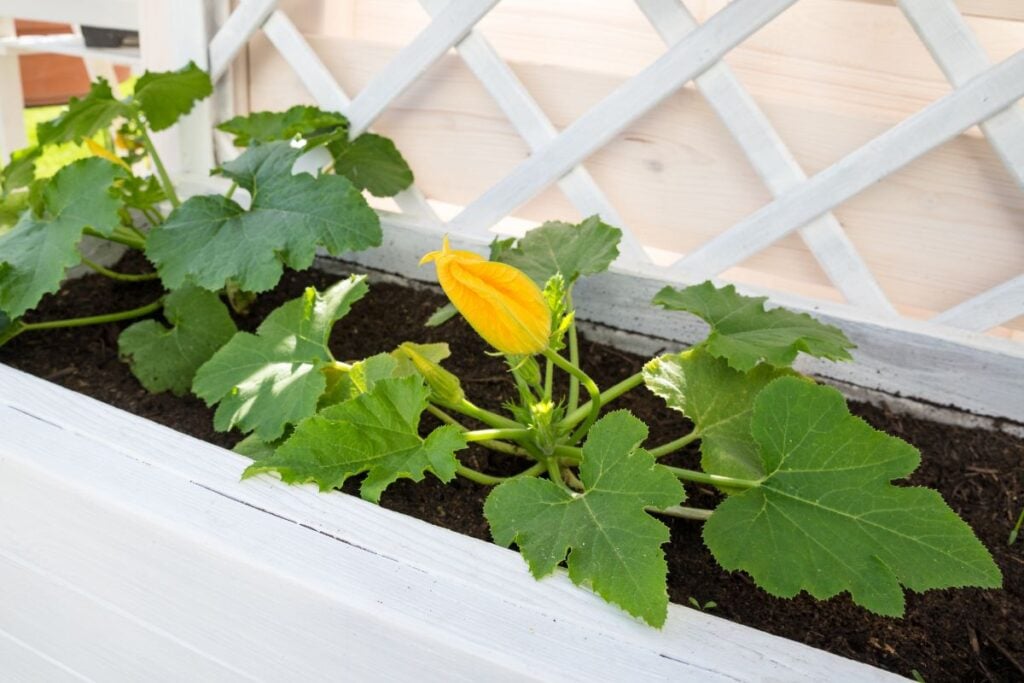
Can I grow zucchinis in a raised bed?
Zucchinis grow well in raised beds.
However, planting zucchinis in raised beds is slightly different from the ground.
Zucchini plants are fast growers but are quite delicate and need lots of care and attention when they are small.
In a raised garden bed, the transplants, as compared to the seeds, grow better.
The seeds are often damaged by frost or wind, due to which the success rate is less.
The correct time for planting seeds in the raised beds is when the weather and soil are warm enough for nourishing and nurturing them.
The seeds will sprout after a few weeks.
However, you can thin them down for the strongest and most successful seedlings.
Avoid sowing the seed if you think the soil is not ready for plantation, and wait until the temperature warms and heats the soil.
Why is proper spacing important for Zucchini plants?
Spacing zucchini plants at a proper distance will help them get all the resources adequately.
1. To generate higher yields
If you space your zucchini plants correctly, they will get plenty of space to grow.
They will not compete for resources like air, sunlight, water, and nutrients with their neighboring plants and will produce higher yields.
2. To reduce the risk of fungal diseases
If you space the zucchini plants closely, they will get overcrowded and start developing fungal diseases like powdery mildew and bacterial wilt.
The air circulation between the plants reduces, due to which these diseases will develop.
3. Ease in harvesting
It becomes quite easier to harvest the fruits if they are spaced correctly.
The other plants will not get damaged while you harvest the zucchinis.
If you closely space the plants, their fruits might get hidden inside the leaves, and you might be unable to spot and pick them at the right time.
Looking for gardening supplies? We have tested 100's of products before recommending them to you guys. Check out our best pick below:
| Image | Gardening Supplies | Best Price? |
|---|---|---|
 Top
Top Top
Top | Raised Garden Bed Kit | Check On Amazon |
 | XLUX Soil Moisture Meter, Plant Water Monitor, Soil Hygrometer Sensor for Gardening, Farming, Indoor and Outdoor Plants, No Batteries Required | No Results |
 Top
Top Top
Top | 82 Pcs Garden Tools Set and Extra Succulent Tools Set | Check On Amazon |
 | Joeys Garden Expandable Garden Hose with 8 Function Hose Nozzle, Lightweight Anti-Kink Flexible Garden Hoses, Extra Strength Fabric with Double Latex Core, (50 FT, Black) | No Results |
 Top
Top Top
Top | Dual Chamber Compost Tumbler | Check On Amazon |
 Top
Top Top
Top | Sunnyglade Plant Stakes | Check On Amazon |
 Top
Top Top
Top | Organic Cold Pressed Neem Seed Oil | Check On Amazon |
 Top
Top Top
Top | Mighty Mint Gallon :-Insect and Pest Control Peppermint Oil | Check On Amazon |
 Top
Top Top
Top | Scotts DiseaseEx Lawn Fungicide | Check On Amazon |
 Top
Top Top
Top | Jacks Classic 20-20-20 All Purpose Fertilizer | Check On Amazon |
 Top
Top Top
Top | 30,000 Seeds Pollinator Attracting Wildflower Mixture | Check On Amazon |
 Top
Top Top
Top | Survival Vegetable Seeds Garden Kit-Over 16,000 Seeds | Check On Amazon |
What are the different zucchini varieties?
The zucchini varieties come in two forms- bushy and vining.
You can grow both varieties in the raised garden bed.
Let us now study the difference between these two varieties with the help of the following table.
| Bush Zucchini variety | Vine Zucchini variety |
|---|---|
| The Bushy Zucchini variety is small, has compact growth, and takes less space to grow. | The vining zucchini variety takes up more growing space, and they can be trained to grow on trellis in small raised beds. |
| The bushy varieties are more suitable for raised beds and containers due to their compact growth. | The vine varieties are less suitable for raised beds and more for large gardens and fields. |
| The bushy zucchini varieties include the baby bush, Seneca gourmet, Mexican globe, silver bush, etc. | The vine zucchini variety includes the long Italian squash, Hubbards, Butternut, Acorn squashes, etc. |
How far apart should you apart Zucchini in raised beds?
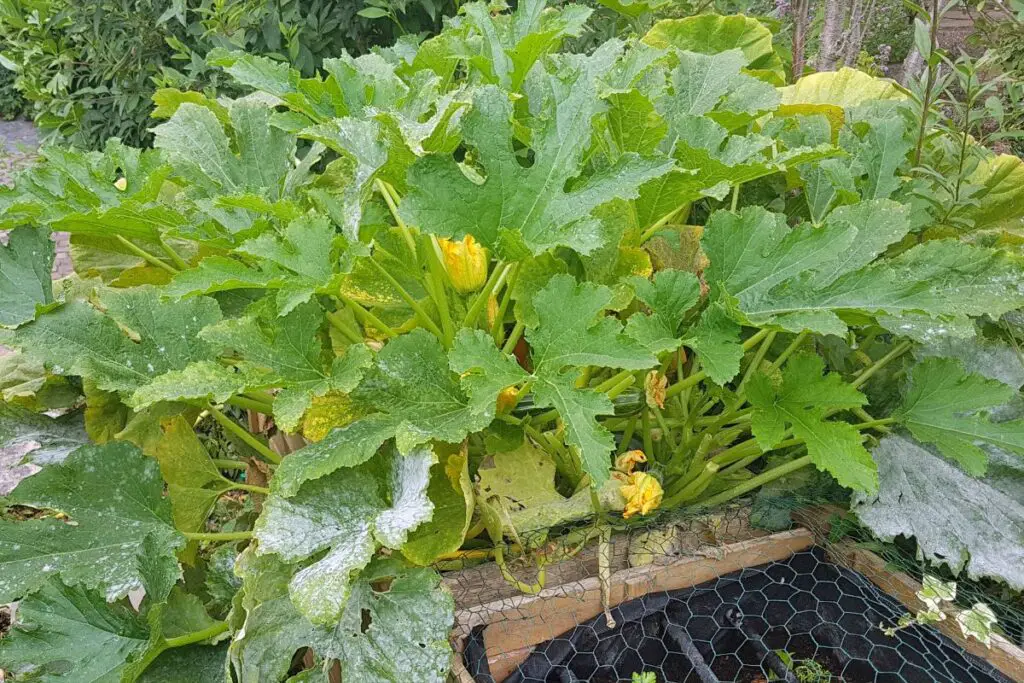
Zucchini plants are heavy feeders and need plenty of nutrients to grow throughout the growing season.
Firstly, if you space the plants closely, they will suck up all the nutrients in a very short time, leading to stunted growth.
Secondly, zucchinis are large, prolific growers, so close spacing will not help them grow.
It would be best to maintain proper distance between the plants so they can grow independently without fighting with their neighboring plants for resources.
The spacing of zucchinis will depend on the growth pattern of the variety and the space available in the raised garden beds.
Let us discuss how far you should apart zucchinis seeds and transplants in detail.
Spacing requirements for Zucchini seeds
If growing the bushy variety, start by sowing 4 to 5 zucchini seeds ½ inch deep and space those 3-4 inches apart and the rows 3 to 4 feet apart.
If you are growing the vining variety, sow 2 to 3 seeds 1 inch deep and space those 3-4 inches apart and the row 4 to 5 feet apart.
It would help if you closely spaced the seeds because there is a high chance that many seeds will be destroyed by winds or frost, and only some will get the success.
Close spacing allows you to sow many seeds and get many plants, even if some are destroyed.
Once the zucchinis seedling is about 1 inch (2.5 cm), start thinning them out.
Choose only the strongest and the healthiest seedling and discard the rest.
Use a sharp sterilized shear for cutting the seedlings, which is not required in the raised bed.
Avoid pulling the plants by the roots since the root system for the other seedlings can get disturbed.
Spacing requirements for Zucchini transplants
If you don’t want to sow the seeds in the raised beds directly, you can start them indoors.
You can transplant the seedlings into the raised beds later when they have a few sets of leaves.
In raised garden beds, space the bush zucchini seedlings 18 to 24 inches apart and the rows 2- 3 feet apart.
On the other hand, the vine zucchini variety should be spaced 24-36 inches apart and the rows 3 feet apart.
If you want to grow zucchinis in more than one row, space each row 36 inches apart from the other row so there is enough space left for walking between rows.
This spacing will give the plants enough space to spread their leaves as they grow.
Spacing requirements for Zucchini grown vertically
If your raised garden bed is very small, you can vertically grow your zucchinis to save space.
You will need a trellis as a support structure for trellising the zucchini vines.
The trellis will help you to increase the yield in a small area because the vines will not sprawl all over the bed.
The ideal distance between plants for vertical zucchini spacing should be 18 inches.
The zucchini plants, as they grow, will get heavy, so ensure that the trellis is strong enough to hold them.
Once your zucchinis are 8 inches tall, start training them to grow vertically with the help of a trellis.
Always prune off the lower leaves to help the plant save energy and the risk of disease spread.
What is the ideal depth of raised beds for planting zucchinis?
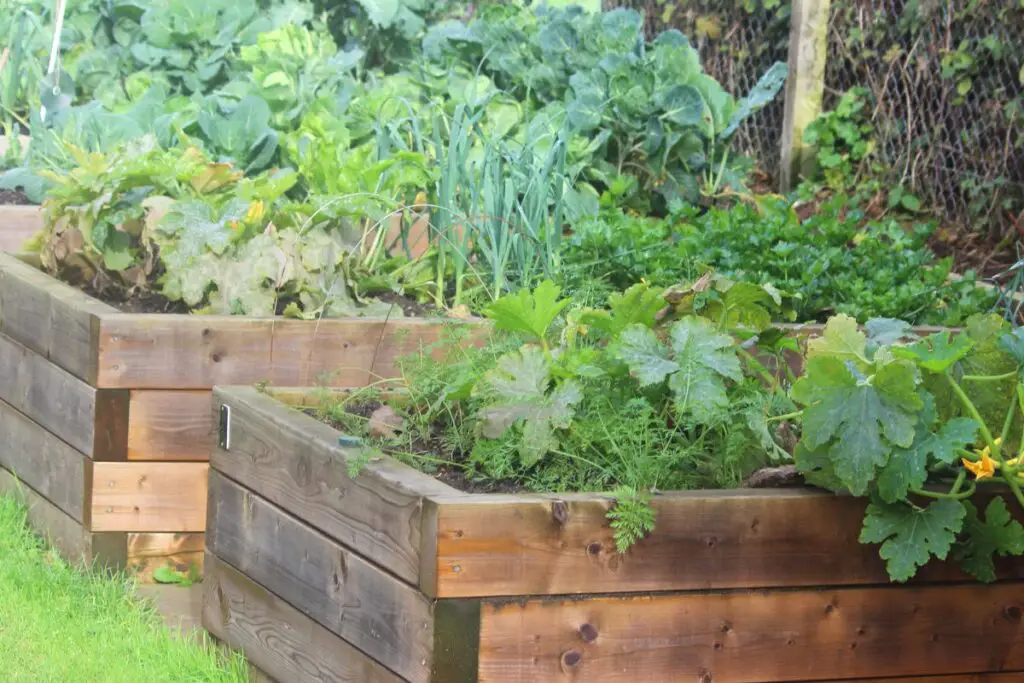
Zucchinis have a long tap root system that grows 3 feet long.
These plants require a deep raised bed since the roots go straight into the soil and need plenty of space to grow.
However, if the raised bed is not connected to the ground, it should be at least 20 inches deep so that the zucchini plants get enough space to grow.
Is trellis necessary for growing zucchinis in raised beds?
Zucchinis plants require a trellis for growing in raised beds, especially if you are growing the vining variety.
When the zucchini plants grow 6 inches long, consider trellising them so that their vines will start to trail and bend over the bed.
But if you don’t want to plant a trellis next to your Zucchini, you need to use twine or twigs to help your plant grow on the trellis.
As the plants grow, you must ensure that the vines bend and traverse around the trellis.
You will also need to guide the young stem through the trellis so that they grow in the desired pattern.
Ensure that all the vines of the Zucchini should get enough sunlight and support from the trellis.
Mistakes you should avoid while growing Zucchini in raised beds:
If your zucchini plants aren’t growing well, you might be doing any of the following mistakes I have listed below.
1. Planting zucchinis in poor soil
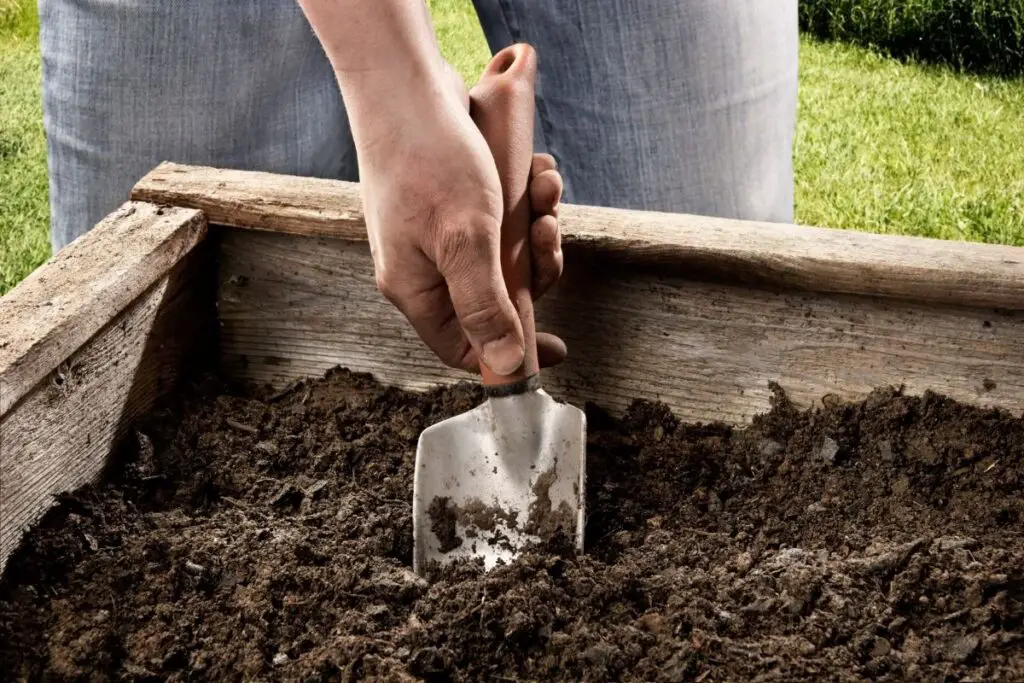
Zucchini plants need nutrient-rich, well-draining, loamy soil to produce fruits throughout the growing season.
They thrive in sandy soil that contains organic matter like compost.
Gardeners sometimes plant zucchinis in the wrong soil and are disappointed with the poor harvest.
Therefore, it’s important to choose or prepare the appropriate soil mix for them.
Remember to fertilize the raised bed 5-7 days before you plant the zucchinis to ensure that there are lots of organic matter and nutrients in the raised bed soil.
Also read: 7 Best DIY Raised Bed Soil Mix: A Step-by-step Guide
2. Choosing a wrong zucchini variety
Like other vegetable crops, Zucchini also comes in different varieties.
The growing area, microclimate, and space in raised bed conditions only support a few zucchini varieties.
Zucchini varieties like Patio star, Black beauty, raven, and the bush baby grow well in the raised garden bed.
These varieties have compact growth with shorter vines suitable for raised beds.
3. Planting the zucchinis in the wrong season
The right time to sow zucchini seeds will depend on your growing season.
If you sow zucchini seeds too early, they might be damaged by frost or snow.
On the other hand, if you sow the seeds too late, they will not get enough growing time to attain maturity and develop fruits.
Therefore, you should sow the seeds only when summer has arrived, the soil has warmed up, and there is no risk of cold injury.
If you live in a place will a cool climate, grow zucchinis in the greenhouse before transplanting them outside, especially for those with a short growing season.
4. Improper watering
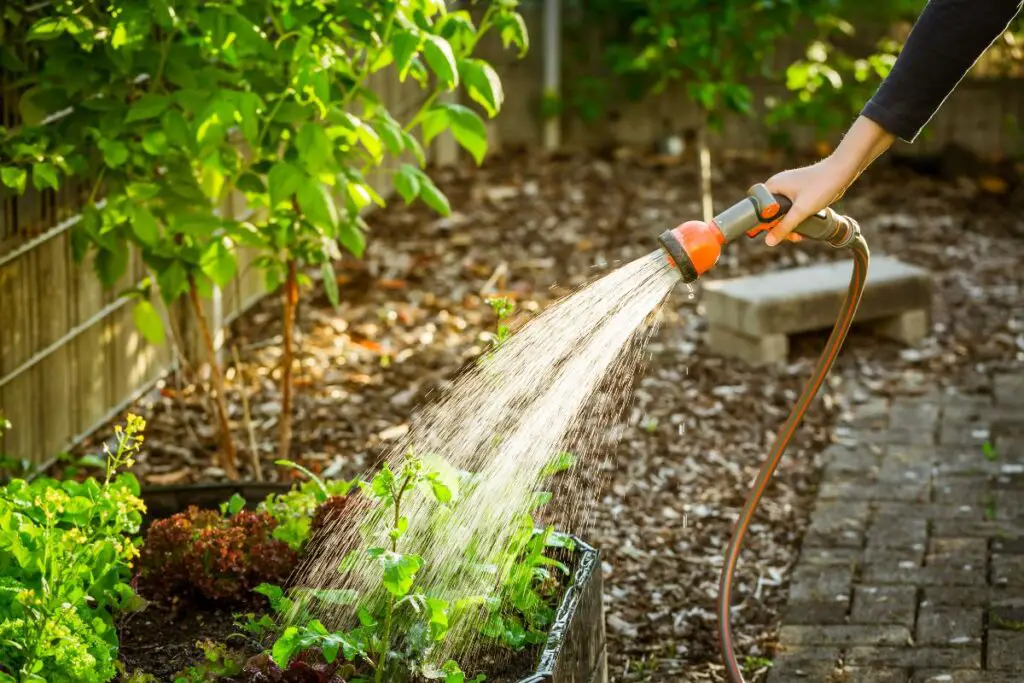
Improper watering can cause a lot of problems for zucchinis.
The zucchini plants are always thirsty and will wilt and die if you do not water them enough.
Overwatering too much is also a big problem you should be aware of.
Watering too much at the base of the plant can cause stem and root rot issues and diseases like powdery mildew.
Provide the zucchini plants with one inch of water weekly to keep the soil moist.
When the plant’s roots are established, cover the raised with a layer of mulch that will retain soil moisture and prevent weeds.
5. Closely spacing the plants
Zucchini plants grow large and, within a short period, can spread over the entire garden bed.
We often space the plants closely without considering their growth patterns, which is one common mistake we all make.
If you space the plants too closely, they will suffer in numerous ways.
Zucchini needs lots of nutrients to grow, and if you don’t keep a distance between them, they will start growing over each over, resulting in small plants.
Hence, it’s crucial to maintain proper spacing between the plants.
Some varieties will need more spacing, so space them accordingly.
6. Under-fertilizing
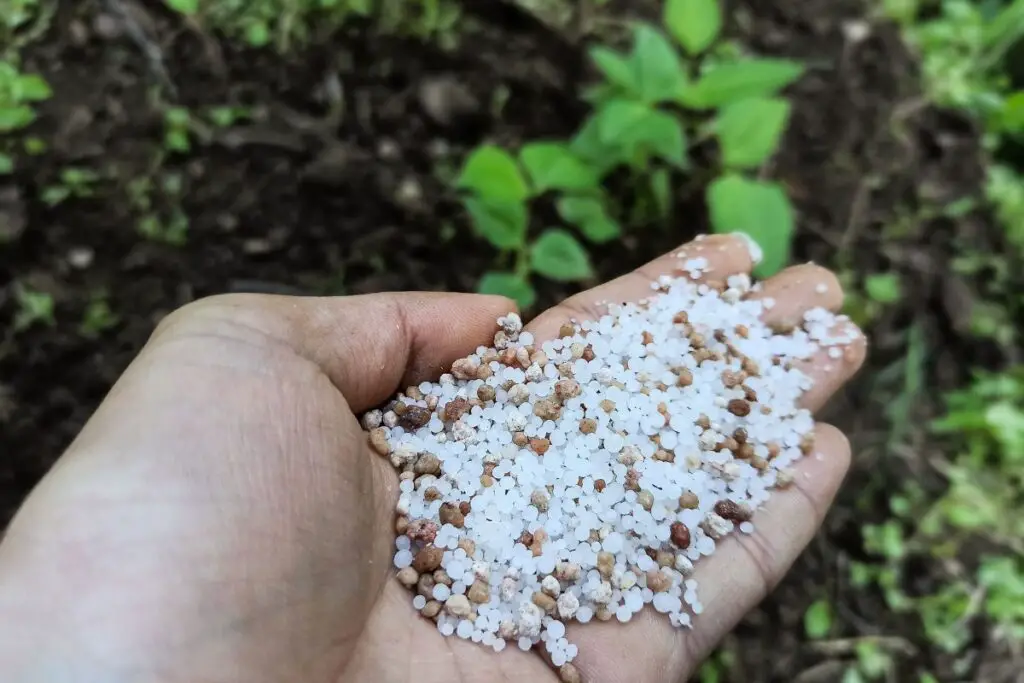
Zucchini are hungry plants that need a relatively high amount of nutrients for producing fruits.
Therefore, they should get fertilized regularly with a high-nutrient fertilizer during the growing season.
To ensure better growth, use a fertilizer that contains more Potassium or Nitrogen.
During the growing season, fertilize the plant every 2 weeks for a good result.
To make the soil more nutritious, you can add an organic mulch that will decompose and add nutrients and minerals to the soil.
Please ensure you never fertilize the plants more than the recommended rate.
Otherwise, their roots will burn and stop growing.
7. Neglecting pests and diseases
Zucchini plants are vulnerable to different pests and fungi, and not paying attention to those is one common mistake we do.
Zucchini can get mostly attacked by pests like cucumber beetles, squash bugs, squash vine borers, and diseases like powdery mildew and bacterial wilt.
It is crucial to check the plants frequently for any signs of problems.
If the pests are caught early, treating and saving the plant will be easier before its severe condition.
8. Not enough light
Zucchini plants need plenty of sunlight to grow and thrive.
Sunlight plays an important role in photosynthesis and provides them with energy.
The raised beds should be placed somewhere where the plants can receive 6 to 8 of sunlight each day.
Also, you can provide the plants with a couple of additional hours of sunlight, as it will boost their growth and increase their yields.
9. Harvesting at the wrong time
Many of us harvest the summer fruits late, thinking that the longer they will grow on the plants, the larger they will become.
However, this isn’t the case with zucchinis.
It is always best to harvest the zucchinis when they are small and tender since they will give the best taste and texture.
The larger Zucchini grows many seeds which may not taste good since they lose a lot of flavor.
They also become tough and lose their tenderness.
If your harvested Zucchini tastes watering and bland, it means you have harvested them late.
Always harvest the zucchinis early so that you can enjoy their best flavors.
Reference: ScienceDirect, American Society of Agronomy, Noble Research Institute, Soil for Raised Beds, Raised Bed Gardening, Tomatoes in the Garden.
